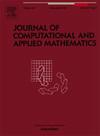利用大迭代路径更新解决著名 SDO 问题的高效二阶预测器-校正器不可行原始双 IPM 算法
IF 2.1
2区 数学
Q1 MATHEMATICS, APPLIED
Journal of Computational and Applied Mathematics
Pub Date : 2024-11-14
DOI:10.1016/j.cam.2024.116379
引用次数: 0
摘要
本文提出了一种新大邻域中半有限优化的二阶预测器-校正器不可行内点算法。新的大邻域基于谱规范,比目前流行的基于负伪无限规范和弗罗贝尼斯规范的大邻域更宽。在每次迭代中,我们的算法都会使用两个修改过的系统和 Yang 等人的策略计算一个新的预测方向。然后,该算法利用在预测器步骤中获得的方向计算二阶校正器方向。迭代是通过在新的大邻域内沿搜索方向取可能的最大步长来确定的。我们证明了该算法具有全局收敛性和 O(n54+1qlogɛ-1) 的迭代复杂度约束。最后,对所提算法的数值实验证实了这种方法的高效性和可靠性。本文章由计算机程序翻译,如有差异,请以英文原文为准。
An efficient second-order predictor–corrector infeasible primal–dual IPM algorithm with large iteration path updates for solving well-known SDO problems
In this paper, we propose a second-order predictor–corrector infeasible interior-point algorithm for semidefinite optimization in a new large neighborhood. The new large neighborhood, which is based on the spectral norm, is wider than the popular large neighborhoods based on the negative pseudo-infinity norm and the Frobenius norm. In each iteration, our algorithm calculates a new predictor direction using two modified systems and Yang et al. strategy. Then, this algorithm calculates a second-order corrector direction using the directions obtained in the predictor step. The iterates are determined by taking the largest possible step lengths along the search directions within the new large neighborhood. We prove that the algorithm is globally convergent and has iteration complexity bound. Finally, the numerical experiments of the proposed algorithm confirm the efficiency and reliability of this approach.
求助全文
通过发布文献求助,成功后即可免费获取论文全文。
去求助
来源期刊
CiteScore
5.40
自引率
4.20%
发文量
437
审稿时长
3.0 months
期刊介绍:
The Journal of Computational and Applied Mathematics publishes original papers of high scientific value in all areas of computational and applied mathematics. The main interest of the Journal is in papers that describe and analyze new computational techniques for solving scientific or engineering problems. Also the improved analysis, including the effectiveness and applicability, of existing methods and algorithms is of importance. The computational efficiency (e.g. the convergence, stability, accuracy, ...) should be proved and illustrated by nontrivial numerical examples. Papers describing only variants of existing methods, without adding significant new computational properties are not of interest.
The audience consists of: applied mathematicians, numerical analysts, computational scientists and engineers.

 求助内容:
求助内容: 应助结果提醒方式:
应助结果提醒方式:


